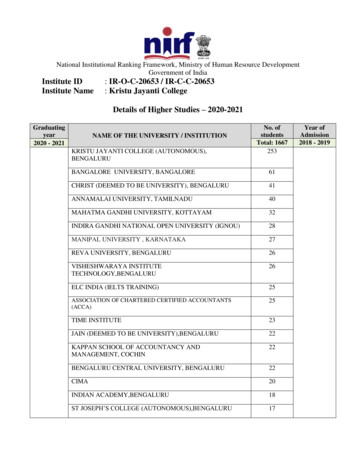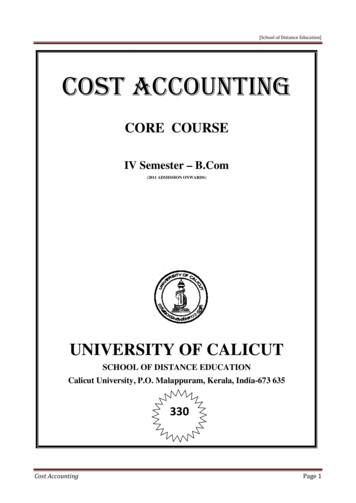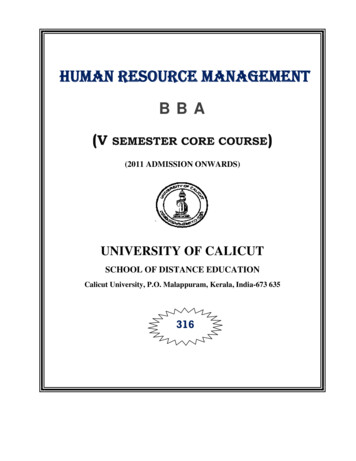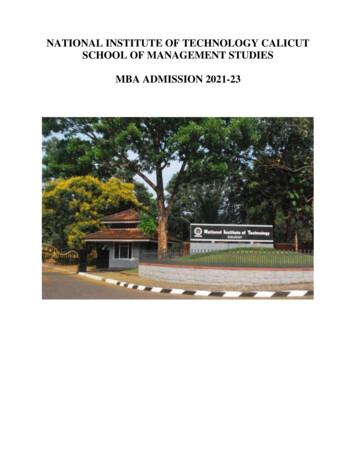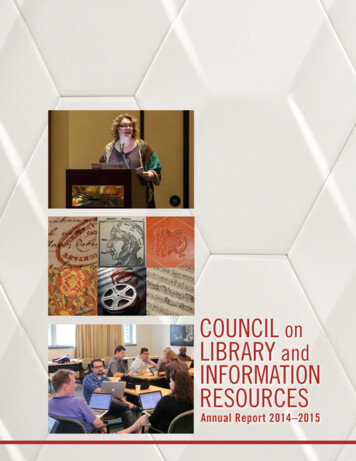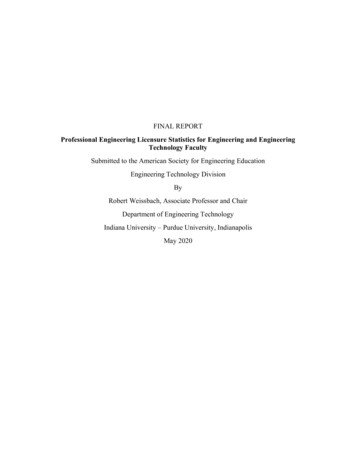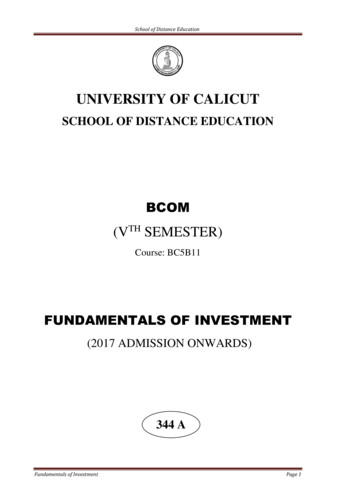
Transcription
School of Distance EducationUNIVERSITY OF CALICUTSCHOOL OF DISTANCE EDUCATIONBCOM(VTH SEMESTER)Course: BC5B11FUNDAMENTALS OF INVESTMENT(2017 ADMISSION ONWARDS)344 AFundamentals of InvestmentPage 1
School of Distance EducationFUNDAMENTALS OF INVESTMENTSTUDY MATERIALVTH SEMESTERCourse: BC5B11BCOM(2017 ADMISSION ONWARDS)UNIVERSITY OF CALICUTSCHOOL OF DISTANCE EDUCATIONCalicut University- PO, Malappuram, Kerala, India - 673 635Fundamentals of InvestmentPage 2
School of Distance EducationUNIVERSITY OF CALICUTSCHOOL OF DISTANCE EDUCATIONSTUDY MATERIALFIFTH SEMESTERBCOM(2017 ADMISSION ONWARDS)Course: BC5B11FUNDAMENTALS OF INVESTMENTPrepared by:Chapter 1 & 4Smt. Greeshma. V,Asst. Professor,P.G Dept. of Commerce,Govt. College, MalappuramChapter 2, 3, & 5Mr. Sanesh. C,Asst. Professor,Dept. of Commerce,Sri Vyasa NSS College,Wadakkanchery, Thrissur.Scrutinized by:Dr. K. Venugopalan,Associate Professor,Department of Commerce,Govt. College, Madappally.Fundamentals of InvestmentPage 3
School of Distance EducationFundamentals of InvestmentPage 4
School of Distance EducationCONTENTCHAPTER 1INVESTMENT ENVIRONMENT6CHAPTER 2FIXED INCOME SECURITIES21APPROACH TO SECURITYCHAPTER 332ANALYSISCHAPTER 4PORTFOLIO ANALYSIS59CHAPTER 5INVESTOR PROTECTION84Fundamentals of InvestmentPage 5
School of Distance EducationCHAPTER 1INVESTMENT ENVIRONMENTThe income that a person receives may be used for purchasing goods and servicesthat he currently requires or it may be saved for purchasing goods and services that he mayrequire in the future .In other words, income can be what is spent for current consumption.savings are generated when a person or organization abstain from present consumption fora future use .The person saving a part of his income tries to find a temporary repository forhis savings until they are required to finance his future expenditure .this result ininvestment.Meaning of investmentInvestment is an activity that is engaged in by people who have savings, i.e.investments are made from savings, or in other words, people invest their savings.But all savers are not investor’s .investment is an activity which is different from saving.Let us see what is meant by investment.It may mean many things to many persons. If one person has advanced somemoney to another, he may consider his loan as an investment. He expect to get back themoney along with interest at a future date .another person may have purchased on kilogramof gold for the purpose of price appreciation and may consider it as an investment.In all these cases it can be seen that investment involves employment of funds withthe main aim of achieving additional income or growth in the values. The essential qualityof an investment is that it involves something for reward. Investment involves thecommitment of resources which have been saved in the hope that some benefits will accruein future.Thus investment may be defined as “a commitment of funds made in theexpectation of some positive rate of return “since the return is expected to realize in future,there is a possibility that the return actually realized is lower than the return expected to berealized. This possibility of variation in the actual return is known as investment risk. Thusevery investment involves return and risk.F. Amling defines investment as “purchase of financial assets that produces a yieldthat is proportionate to the risk assumed over some future investment period.” Accordingto sharpe,”investment is sacrifice of certain present value for some uncertain futurevalues”.Fundamentals of InvestmentPage 6
School of Distance EducationInvestment decision processInvesting has been an activity confined to the rich and business class in the past.But today, we find that investment has become a house hold word and is very popular withpeople from all walks of life .India appears to be slowly but surely closing in some of thetop savers among countries in the global peaking order. savings in Indians touched a newhigh of 31percent of the GDP during2011-2012.chain leads the pack of savers with thesaving figure at close to 49 percent of GDP followed by other emerging market economieslike Bangladesh 36 percent, Bhutan 48 percent of their GDP. The escalating cost due to,inflation are decreasing the value of saved money with each passing year .consider the costbuying a home ,of getting admitted in a hospital or paying for the higher education of achild. One’s life’s savings could vanish in a blink. Knowledgeable investing requires theinvesting to be aware of his needs the amount of money he can invest and the investmentoptions available to him .These will relate to the investment decision process. A typicalinvestment decision goes through a five step procedure which is known as investmentprocess these steps are:1. Defining the investment objective2. Analyzing securities3. Construct a portfolio4. Evaluate the performance of portfolio5. Review the portfolio1. Defining the investment objectiveInvestment objective may vary from person to person .it should be stated in termsof both risk and return .In other words ,the objective of an investor is to make moneyaccepting the fact of risks that likely to happen .The typical objectives of investor includethe current income ,capital appreciation, and safety of principal. More over constrainsarising due to liquidity, the time horizon, tax and other special circumstances, if any mustalso be considered this steps of investment process also identifies the potential financialassets that may be included in the portfolio based on the investment objectives.2. Analyzing securitiesThe second steps of analyzing securities enable the investor to distinguish between underpriced andoverpriced stock. Return can be maximized by investing in stocks which are currently underpricedFundamentals of InvestmentPage 7
School of Distance Educationbut have the potential to increase .it might be useful to remember the golden principle of investment;buy low sell high. There are two approaches used for analyzing securities; technical analysis andfundamental analysis.3. Construct a portfolioThe actual construction of portfolio, which can be divided into three sub parts.a) How to allocate the portfolio across different asset classes such as equities, fixedincome securities and real assetsb) The assets selection decision, this is the step where the stocks make up the equitycomponent, the bonds that make up the fixed income component.c) The final component is execution, where the portfolio is actually put together, whereinvestors have to trade off transaction cost against transaction speed.4. Evaluate the performance of portfolioThe performance evaluation of the portfolio done on the in terms of risk and return.Evaluation measures are to be developed .CAGR(compounded annual growth rate) may beone criteria. Hindustan unilever gave a CAGR of 21 percent in returns to the shareholdersfor the last 13 years.5. Review the portfolioIt involves the periodic repetition of the above steps. The investment objective of aninvestor may change overtime and the current portfolio may no longer be optimal for him.so the investor may form a new portfolio by selling certain securities and purchasing othersthat are not held in the current portfolio.Types of InvestmentsNonnegotiablesecuritiesDeposits earn fixed rate of return. Even though bank deposits resemble fixed incomesecurities they are not negotiable instruments. Some of the deposits are dealt subsequently.a) Bank depositsIt is the simplest investment avenue open for the investors. He has to open an account and deposit themoney. Traditionally the banks offered current account, Saving account and fixed deposits account.Current account does not offer any interest rate. The drawback of having large amount in savingaccounts is that the return is just 4 percent. The saving account is more liquid and convenient toFundamentals of InvestmentPage 8
School of Distance Educationhandle. The fixed account carries high interest rate and the money is locked up for a fixed period.With increasing competition among the banks, the banks have handled the plain saving account withthe fixed account to cater to the needs of the small savers.b) Post office depositsPost office also offers fixed deposit facility and monthly income scheme. Monthlyincome scheme is a popular scheme for the retired, an interest rate of 9 percent is paidmonthly .the term of the scheme is 6 years, at the end of which a bonus of 10 percent ispaid .the annualized yield to maturity works out to be 15.01 per annum, after three years,premature closure is allowed without any penalty .if the closure is one year, a penalty of 5percent is charged.NBFC depositsIn recent years there has been a significant increase in the importance of nonbanking financial companies in the process of financial intermediation. The NBFC comeunder the purview of the RBI. The Act in January 1997, made registration compulsory forthe NBFCs1) Period the period ranges from few months to five years.2) Maximum limit the limit for acceptance of deposit has been on the credit rating of thecompany.3)Interest NBFCs have been debarred from offering an interest rate exceeding 16% perannum and a brokerage fee over 2% on public deposit. The interest rate differs accordingto maturity period.Tax sheltered saving schemeThe important tax sheltered saving scheme isa) public provident fund scheme(PPF)PPF earn an interest rate of 8.5% per annum compounded annually. Which is exemptedfrom the income tax under sec80 C.The individuals and Hindu undivided families canparticipate in this scheme. There is a lock in period of 15years.PPF is not indented forthose who are liquidity and short term returns. at the time of maturity no tax is to be given.b) National saving scheme(NSS)This scheme helps in deferring the tax payment. Individuals and HUF are eligible toopen NSS account in the designated post office.Fundamentals of InvestmentPage 9
School of Distance Educationc) National saving certificateThis scheme is offered by the post office. These certificate come in the denomination ofRs.500,1000,5000 and 10000.the contribution and the interest for the first five years are covered bysec 88.the interest is cumulative at the rate of 8.5%per annum and payable biannually is covered bysec 80 L.Life insuranceLife insurance is a contract for payment of a sum of money to the person assured onthe happening of event insured against. Usually the contract provides for the payment of anamount on the date of maturity or at a specified date or if unfortunate death occurs. Themajor advantage of life insurance is given below;1) Protection saving through life insurance guarantees full protection against risk ofdeath of the saver. The full assured sum is paid, whereas in other schemes only theamount saved is paid.2) Easy payments for the salaried people the salary saving schemes are introduced.Further there is an installment facility method of payment through monthly, quarterly,half yearly or yearly mode.3) Liquidity loans can be raised on the security of the policy4) Tax relief tax relief in income tax and wealth tax is available for amounts paid byway of premium for life insurance subject to the tax rates in force.Type of life insurance policya) Endowment policy;The objective of this policy is to provide an assured sum, both in the event of thepolicy holders’ death or at the expiry of the policy.b) Term policy:In a term policy investor pays a small premium to insure his life for a comparativelyhigher value. The objective behind the scheme is not to get any amount on the expiryof the policy. But simply to ensure the financial future of the investors dependents.c) Whole life policyIt is a low cost insurance plan where the sum assured is payable on the death of thelife insured and premium are payable throughout life.Fundamentals of InvestmentPage 10
School of Distance Educationd) Money back policyThe insurance company pays the sum assured at periodical intervals to the policyholder plus the entire sum assured to the beneficiaries in case of the policy holders demisebefore maturity.e) ULIPs:Unit Linked Insurance Policies are a combination of mutual fund and life insurance.Investments in ULIPs have two component-one part is used as a premium for life insurancewhile the other part acts s the investment fund.The investment component works exactly like mutual fund money is invested instocks, bonds; government securities etc., an investor receive money in return.Mutual fundInvesting directly in equity shares, and debt instruments may be difficult task for alarge number of customers because they want to know more about the company, promoter,prospects, competition for the product etc.in such a case, investor can go for investing infinancial assets indirectly through mutual fund. A mutual fund is a trust that pools thesavings of a number of investors who share a common financial goal. Each scheme of amutual fund can have different character and objectives.Types of return Capital appreciation: an increase in the value of the units of the fund is known ascapital appreciation Dividend distribution: the profit earned by the fund is distributed among unitholders in the form of dividends.Type of mutual funds Open ended schemes:In this scheme there is an uninterrupted entry and exist into the funds. The openended scheme has no maturity period and they are not listed in the stock exchanges.The open ended fund provides liquidity to the investors since repurchase available. Closed ended funds:The closed ended funds have a fixed maturity period. The first time investmentsFundamentals of InvestmentPage 11
School of Distance Educationare made when the close ended scheme is kept open for a limited period. Onceclosed, the units are listed on a stock exchange .investors can buy and sell theirunits only through stock exchanges.Other classification Growth scheme: aims to provide capital appreciation over medium to long term.Generally these funds invest their money in equities. Income scheme: aims to provide a regular return to its unit holders. Mostly thesefunds deploy their funds in fixed income securities.Balanced scheme: a combination of steady return as well as reasonable growth. The fund ofthis scheme is invested in equities and debt instruments. Money market scheme: this type of fund invests its money to money marketinstruments. Tax saving scheme: this type of scheme offers tax rebates to investors. Index scheme: Here investment is made on the equities of the Stock index.Real estateThe real estate market offers a high return to the investors. The word real estate means landand buildings. There is a normal notion that the price of the real estate has increased bymore than 12% over the past ten years. Real estate investments cannot be enchasedquickly. Liquidity is a problem. Real estate investment involves high transaction cost. Theasset must be managed, i.e. painting, repair, maintenance etc.CommoditiesCommodities have emerged as an alternative investment option now a days and investorsmake use of this option to hedge against spiraling inflation- commodities may be broadlydivided into three. Metals, petroleum products and agricultural commodities .Metals can bedivided in to precious metals and other metals. Gold and silver are the most preferred oncefor beating inflation.GoldOff all the precious metals gold is the most popular as an investment. Investors generallybuy gold as a hedge against economic, political, social fiat currency crisis. Gold prices aresoaring to the new highs in recent years comparing to the previous decades becauseFundamentals of InvestmentPage 12
School of Distance Educationwhenever the signs of an economic crisis arises in the world markets may find shelter ingold as safest asset class for investors all around the world.SilverYellow metal is treated as safe haven .but silver is used abundantly for industrialapplications. Investment in silver has given investor, super returns than what gold hasgiven.Concept of risk and returnAny rational investor, before investing his or her investable wealth in the stock, analysisthe risk associated with the particular stock. The actual return he receives from a stock mayvary from his expected return and is expressed in the variability of return.RiskThe dictionary meaning of risk is the possibility of loss or injury; risk the possibility of not gettingthe expected return. The difference between expected return and actual return is called the risk ininvestment. Investment situation may be high risk, medium and low risk investment.Ex ;1.Buying government securitieslow risk2.Buying shares of an existing Profit making companyMedium risk3. Buying shares of a new companyHigh riskTypes of risk Systematic risk:The systematic risk is caused by factors external to the particular company anduncontrollable by the company. The systematic risk affects the market as awhole. Unsystematic risk:In case of unsystematic risk the factors are specific, unique and related to theparticular industry or company.Sources of riskInterest rate risk:Interest rate risk is the variation in the single period rates of return caused by thefluctuations in the market interest rate. Most commonly the interest rate risk affectsFundamentals of InvestmentPage 13
School of Distance Educationthe debt securities like bond, debentures.Market risk:Jack clarkfrancis has defined market risk as that portion of total variability of returncaused by the alternating forces of bull and bear market. This is a type of systematicrisk that affects share .market price of shares move up and down consistently forsome period of time.Purchasing power riskAnother type of systematic risk is the purchasing power risk .it refers to the variationin investor return caused by inflation.Business risk: Every company operates with in a particular operating environment,operating environment comprises both internal environment within the firm andexternal environment outside the firm. Business risk is thus a function of theoperating conditions faced by a company and is the variability in operating incomecaused by the operating conditions of the company.Financial riskIt refers to the variability of the income to the equity capital due to the debt capital.Financial risk in a company is associated with the capital structure of the company.The debt in the capital structure creates fixed payments in the form of interest thiscreates more variability in the earning per share available to equity share holders.this variability of return is called financial risk and it is a type of unsystematic risk.ReturnThe major objective of an investment is to earn and maximize the return. return oninvestment may be because of income, capital appreciation or a positive hedgeagainst inflation .income is either interest on bonds or debenture , dividend onequity, etcRate of return :The rate of return on an investment for a period is calculated asfollows:Rate of return annual income (ending price –beginning price)Beginning priceEx: Ajay brought a share of a co.for Rs.140 from the market on 1/6/2012.the co. paiddividend of Rs.8 per share .later ajay sold the share at Rs.160 on 1/6/2013.Fundamentals of InvestmentPage 14
School of Distance EducationThe rate of return 8 (160-140)x100 20percent140Security Market IndicesStock market indices are the barometers of the stock market. They mirror the stockmarket behavior. With some 7,000 companies listed on the Bombay stock exchange, it isnot possible to look at the prices of every stock to find out whether the market movement isupward or downward. The indices give a broad outline of the market movement andrepresent the market. Some of the stock market indices are BSE Sensex, BSE-200, Dollex,NSE-50, CRISIL-500, MCX-SX 40, Business Line 250 and RBI Indices of OrdinaryShares.Usefulness of Indices1. Indices help to recognize the broad trends in the market.2. Index can be used as a bench mark for evaluating the investor’s portfolio.3. Indices function as a status report on the general economy. Impacts of the variouseconomic policies are reflecting on the stock market.4. The investor can use the indices to allocate funds rationally among stocks. To earnreturns on par with the market returns, he can choose the stocks that reflect the marketmovement.5. Index funds and futures are formulated with the help of the indices. Usually fundmanagers construct portfolios to emulate any one of the major stock market index. ICICIhas floated ICICI index bonds. The return of the bond is linked with the indexmovement.6. Technical analysts studying the historical performance of the indices predict thefuture movement of the stock market. The relationship between the individual stock andindex predicts the individual share price movementComputation of Stock IndexA stock market index may either be a price index or a wealth index. Theunweighted price index is a simple arithmetical average of share prices with a base date.This index gives an idea about the general price movement of the constituents that reflectsthe entire market. In a wealth index the prices are weighted by market capitalization. Insuch an index, the base period values are adjusted for subsequent rights and bonus offers.This gives an idea about the real wealth created for shareholders over a period of time.Fundamentals of InvestmentPage 15
School of Distance EducationThe Composition of the StocksThe composition of the stocks in the index should reflect the market movement aswell as the macroeconomic changes. The Centre for Monitoring Indian Economy maintainsan index. If often changes the composition of the index so as to reflect the marketmovements in a better manner. Some of the scrip’s traded volume may fall down and at thesame time some other stock may attract the market interest should be dropped and othersmust be added. Only then, the index would become more representative. In 1993, sensexdropped one company and added another. In August 1996 sensex was thoroughlyrevamped. Half of the scrips were changed. The composition of the Nifty was changed inApril 1996 and 1998. Crisils 500 was changed in November 1996. In October 1998 theNifty Junior Index composition has been changed. Recognising the importance of theinformation technology scrips, they are included in the index.NSE - 50 Index – (NIFTY)NIFTY index is the security market indice of National Stock Exchange[NSE].itcomposes 50 leading stocks from different sectors of the listed companies in NSE.Thisindex is built by India Index Services Product Ltd (IISL and Credit Rating InformationServices of India Ltd. (CRISIL).The CRISIL has a strategic alliance with Standard andPoor rating Services. Hence, the index is named as S & P CNX Nifty. NSE - 50 index wasintroduced on April 22, 1996 with the objectives given below :Reflecting market movement more accurately* Providing fund managers a tool for measuring portfolio returns vis-market return.* Serving as a basis for introducing index based derivatives.Nifty replaced the earlier NSE - 100 index, which was established as an interimmeasure till the time the automated trading system stablised. To make the process ofbuilding an index as interactive and user driven as possible an index committee isappointed. The composition of the committee is structured to represent stock exchanges,mutual fund managers and academicians. To reflect the dynamic changes in the capitalmarket, the index set is reduced and modified by the index committee based on certainpredetermined entry and exit criteria.The current composition of Nifty stocks with sector given below [December 2013].Company NameIndustryACC Ltd.CEMENT & CEMENT PRODUCTSAmbuja Cements Ltd.CEMENT & CEMENT PRODUCTSFundamentals of InvestmentPage 16
School of Distance EducationAsian Paints Ltd.CONSUMER GOODSAxis Bank Ltd.FINANCIAL SERVICESBajaj Auto Ltd.AUTOMOBILEBank of BarodaFINANCIAL SERVICESBharat Heavy Electricals Ltd.INDUSTRIAL MANUFACTURINGBharat Petroleum Corporation Ltd.ENERGYBharti Airtel Ltd.TELECOMCairn India Ltd.ENERGYCipla Ltd.PHARMACoal India Ltd.METALSDLF Ltd.CONSTRUCTIONDr. Reddy's Laboratories Ltd.PHARMAGAIL (India) Ltd.ENERGYGrasim Industries Ltd.CEMENT & CEMENT PRODUCTSHCL Technologies Ltd.ITHDFC Bank Ltd.FINANCIAL SERVICESHero MotoCorp Ltd.AUTOMOBILEHindalco Industries Ltd.METALSHindustan Unilever Ltd.CONSUMER GOODSHousing Development FinanceFINANCIAL SERVICESCorporation Ltd.I T C Ltd.CONSUMER GOODSICICI Bank Ltd.FINANCIAL SERVICESIDFC Ltd.FINANCIAL SERVICESIndusInd Bank Ltd.FINANCIAL SERVICESInfosys Ltd.ITJaiprakash Associates Ltd.CONSTRUCTIONJindal Steel & Power Ltd.METALSKotak Mahindra Bank Ltd.FINANCIAL SERVICESLarsen & Toubro Ltd.CONSTRUCTIONFundamentals of InvestmentPage 17
School of Distance EducationLupin Ltd.PHARMAMahindra & Mahindra Ltd.AUTOMOBILEMaruti Suzuki India Ltd.AUTOMOBILENMDC Ltd.METALSNTPC Ltd.ENERGYOil & Natural Gas Corporation Ltd.ENERGYPower Grid Corporation of India Ltd.ENERGYPunjab National BankFINANCIAL SERVICESRanbaxy Laboratories Ltd.PHARMAReliance Industries Ltd.ENERGYSesa Sterlite Ltd.METALSState Bank of IndiaFINANCIAL SERVICESSun Pharmaceutical Industries Ltd.PHARMATata Consultancy Services Ltd.ITTata Motors Ltd.AUTOMOBILETata Power Co. Ltd.ENERGYTata Steel Ltd.METALSUltraTech Cement Ltd.CEMENT & CEMENT PRODUCTSWIPROITBse SensexThe S&P BSE SENSEX (S&P Bombay Stock Exchange Sensitive Index), alsocalled the BSE 30 or simply the SENSEX, is a free float market weighted index of 30 wellestablished and financially sound companies listed on Bombay Stock Exchange. The 30component companies which are some of the largest and most actively traded stocks, arerepresentative of various industrial of the Indian economy. Published since 1 January 1986,the S&P BSE SENSEX is regarded as the pulse of the domestic stock markets in India. Thebase value of the S&P BSE SENSEX is taken as100 on 1 April 1979, and its base year as1978–79. On 25 July 2001 BSE launched DOLLEX-30, a dollar-linked version of S&PBSE SENSEX.Fundamentals of InvestmentPage 18
School of Distance EducationMCX SX 40MCX Stock Exchange Limited (MCX-SXAT) is an Indian stock exchange.SX40 is the flagship Index of MCX-SXAT. A free float based index of 40 large cap-liquid stocks representing diversified sectors of the economy. It is designed to be aperformance benchmark and to provide for efficient investment and risk managementinstrument. It would also help in structuring passive investment vehicles.Information sourcesLearning about investing means learning how money makes money. No one willwatch over your investments more closely or carefully as you yourself, and this is as gooda reason as any to learn as much as you can and become as knowledgeable and savvy aboutinvesting as possible. This holds true even if you determine to have a financial planner oradvisor manage your investmentfunds.Becoming "Investment Literate"It is important to be an informed investor. Financial websites, periodicals,investment books and publications will keep you up to date and educated about investing,about what is going on in the economy, what influences your money, your invested funds,and where your money can be placed so that it will work hardest for you. These sourcescontain valuable information about business in general, as well as current economic andfinancial trends, news of the stock market and related news stories, all those things thataffect the investment community in general, and most importantly, that affect yourinvestments and investment decisions.There is a wealth of financial and investment information available to the individual investor, andone of your tasks if you wish to be an informed investor is to distil this volume of information inorder to find those sources that you can understand, that you are comfortable using, that provideinformation that is clear, reliable, and, as much as possible, independent of bias.Sources of Investment InformationThe following sources of investment information are intended as a starting point.They are stepping stones. As you proceed to research, investigate, educate yourself andlearn, you will find that one place of information will lead you to the next, and you willfind yourself gaining the knowledge that you need in order to become a most successfulinvestor. Becoming investment literate is an on-going process.Fundamentals of InvestmentPage 19
School of Distance EducationBooks“The Intelligent Investor”, written by Benjamin Graham - recognized as one of theclassic texts on investing, value investing specifically. A comprehensive, essential text forany serious student of investing.Financial websitesMSN Money (moneycentral.msn.com) - up to date financial news, aneducational/investing center, stock, bond, and mutual fund research and evaluationresources, help with personal finance and more.CNNMoney.com (money.cnn.com) - as with MSN Money, a comprehensivefinancial site including current news affecting the economy and the investment community.The site also provides a very helpful, step-by-step, personal finance money guide, Money101.Morningstar (www.morningstar.com)-acomprehensiveresearch andevaluation site for stocks, bonds, ETF's (exchange traded funds), and mutual funds,utilizing the Morningstar rating system for investment screening.Newspapers and periodicalsFollowing are the major financial dailies available in Indian news paper industry The Hindu- Business LINE The Economic TIMESFollowing are the major financial periodicals available in Indian news paper industryThe Business EnterpriseBusiness IndiaBusiness Today (business magazine)BusinessworldDhanam MagazineFundamentals of InvestmentPage 20
School of Distance EducationCHAPTER 2FIXED INCOME SECURITIESFixed income securities-IntroductionRetail investors in India can be said to be reasonably well informed when it comesto investments in equities, real estate or even assets like gold or silver. The Fixed I
A typical investment decision goes through a five step procedure which is known as investment process these steps are: 1. Defining the investment objective 2. Analyzing securities 3. Construct a portfolio 4. Evaluate the performance of portfolio 5. Review the portfolio 1. Defining the investment objective
